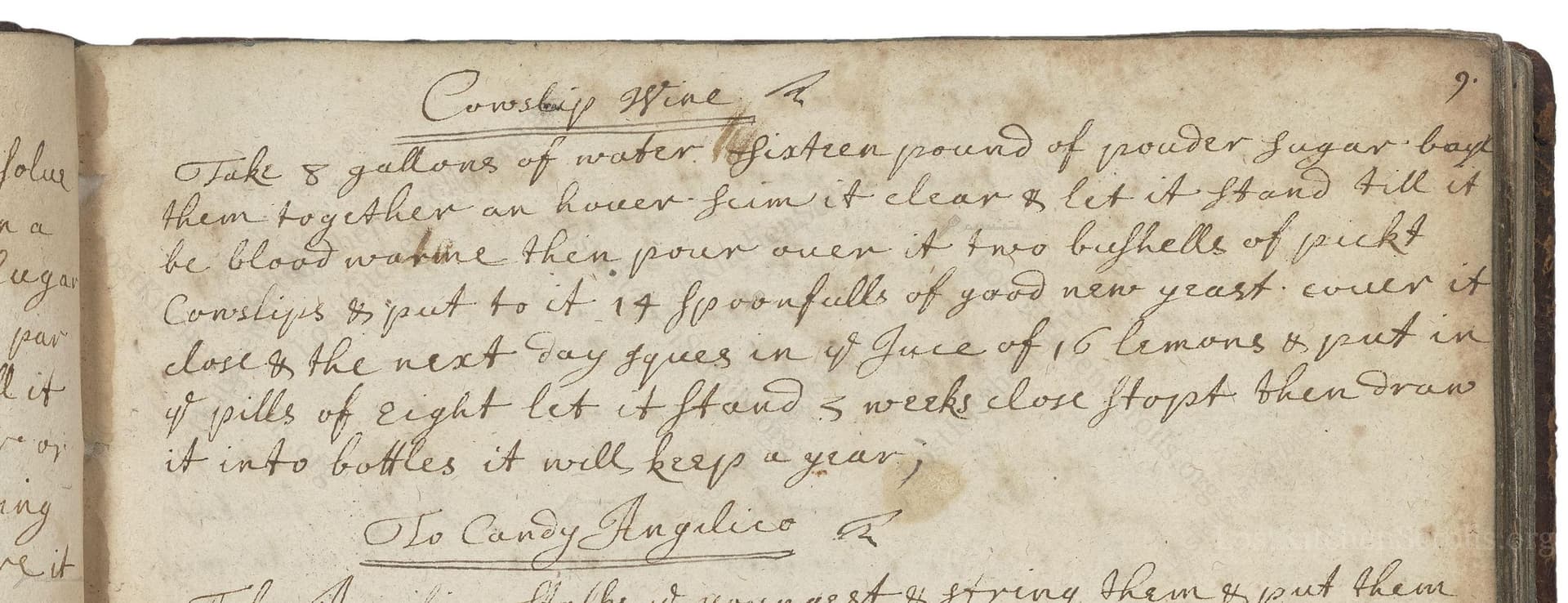Cowslip Wine
From the treasured pages of Cookbook of Jane Dawson
Written by Jane Dawson

Cowslip Wine
"Take 8 gallons of water. Sixteene pound of pouder Sugar. boyl them together an hower. Scim it cleare & let it Stand till it be blood warme then pour on two bushells of pickt CowSlips & put to it 14 Spoonfulls of good new yeaft. cover it clofe & the next day SquieS in 9 Juice of 16 lemons & put in 9 pills of Eight let it Stand 5 weeks close Stopt then draw it into bottles it will Keep a year;"
Note on the Original Text
This recipe is a classic example of 17th-century English household writing: quantities are grand, measurements imprecise, and directions assume some brewing know-how. The spelling follows period conventions—'yeaft' for yeast, and 'clofe' for close, among others. Instructions unfold as a continuous narrative rather than in the stepwise style of today. Notably, cowslip wine recipes like this were less about purity of alcohol and more about pleasure and preservation, capturing and extending the joys of spring via the kitchen alchemy of fermentation.

Title
Cookbook of Jane Dawson (1690)
You can also click the book image above to peruse the original tome
Writer
Jane Dawson
Era
1690
Publisher
Unknown
Background
A delightful glimpse into late 17th-century English kitchens, Jane Dawson's recipe collection is a flavorful tapestry of sweet delicacies and savory dishes, revealing the tastes and ingenuity of bygone home cooks.
Kindly made available by
Folger Shakespeare Library
This delightful recipe for cowslip wine hails from late 17th-century England, found in the manuscript cookbook of Jane Dawson, an early modern housewife. Home winemaking using seasonal wildflowers like cowslips was a cherished custom for country families, capturing the fleeting fragrances of spring. Cowslip (Primula veris) was abundant in English meadows and prized both for its gentle floral aroma and its purported medicinal properties. Such recipes were generally the domain of women managing household provisions, and documented with an assumption of familiarity with the basic techniques of brewing and fermenting. Home-brewed wines like this would take pride of place at genteel tables, often served on festive occasions.

Historically, this wine would be made with large copper or iron cauldrons for boiling the water and sugar. After cooling, the mixture went into wooden tubs, earthenware crocks, or large stoneware jars for fermentation. The flowers were picked using baskets, and the lemons juiced with knives and wooden presses. The liquid was strained with muslin or fine cloth, then bottled into glass bottles with corks and paraffin wax or leather seals. A cool cellar or larder was essential for safe storage during fermentation and aging.
Prep Time
30 mins
Cook Time
1 hr
Servings
40
We've done our best to adapt this historical recipe for modern kitchens, but some details may still need refinement. We warmly welcome feedback from fellow cooks and culinary historians — your insights support the entire community!
Ingredients
- 8 gallons water
- 16 pounds granulated white sugar
- 16 gallons cowslip flowers (Primula veris), thoroughly picked and cleaned (substitute: mix of primrose and meadowsweet if cowslip unavailable)
- 0.46 pounds fresh baker's yeast (about 14 tablespoons)
- Juice of 16 lemons
- Zest of 8 lemons (from untreated/unwaxed lemons)
Instructions
- Begin by bringing 8 gallons of water and 16 pounds of granulated white sugar to a boil in a large sanitized pot.
- Boil together for one hour, skimming off any froth that forms to keep the mixture clear.
- Remove from heat and allow to cool until it is about blood temperature (98.6°F).
- Add in approximately 16 gallons (two bushels) of carefully picked cowslip flowers (ensure no green parts for best flavor), and stir in 0.46 pounds (about 14 tablespoons) of fresh baker’s yeast.
- Cover the pot loosely and leave it to ferment overnight.
- The following day, squeeze the juice from 16 lemons and add it to the mix along with the zest of 8 lemons.
- Stir thoroughly, then cover and allow to ferment for five weeks in a cool, dark place, keeping the vessel tightly sealed.
- After five weeks, strain to remove all solids and decant the liquid into sterilized bottles.
- Seal and store in a cool spot.
- Allow to age for several months; the wine will keep for up to one year.
Estimated Calories
150 per serving
Cooking Estimates
It takes about 1 hour to boil the sugar and water, plus around 30 minutes to prep the flowers and lemons. Preparing and combining the ingredients takes about 1.5 hours. The fermentation process is long but hands-off, and not included in the times. Each serving has roughly 150 calories. The recipe yields about 40 servings.
As noted above, we have made our best effort to translate and adapt this historical recipe for modern kitchens, taking into account ingredients nowadays, cooking techniques, measurements, and so on. However, historical recipes often contain assumptions that require interpretation.
We'd love for anyone to help improve these adaptations. Community contributions are highly welcome. If you have suggestions, corrections, or cooking tips based on your experience with this recipe, please share them below.
Join the Discussion
Rate This Recipe
Dietary Preference

Den Bockfisch In Einer Fleisch Suppen Zu Kochen
This recipe hails from a German manuscript cookbook compiled in 1696, a time whe...

Die Grieß Nudlen Zumachen
This recipe comes from a rather mysterious manuscript cookbook, penned anonymous...

Ein Boudain
This recipe comes from an anonymous German-language manuscript cookbook from 169...

Ein Gesaltzen Citroni
This recipe, dating from 1696, comes from an extensive anonymous German cookbook...
Browse our complete collection of time-honored recipes



